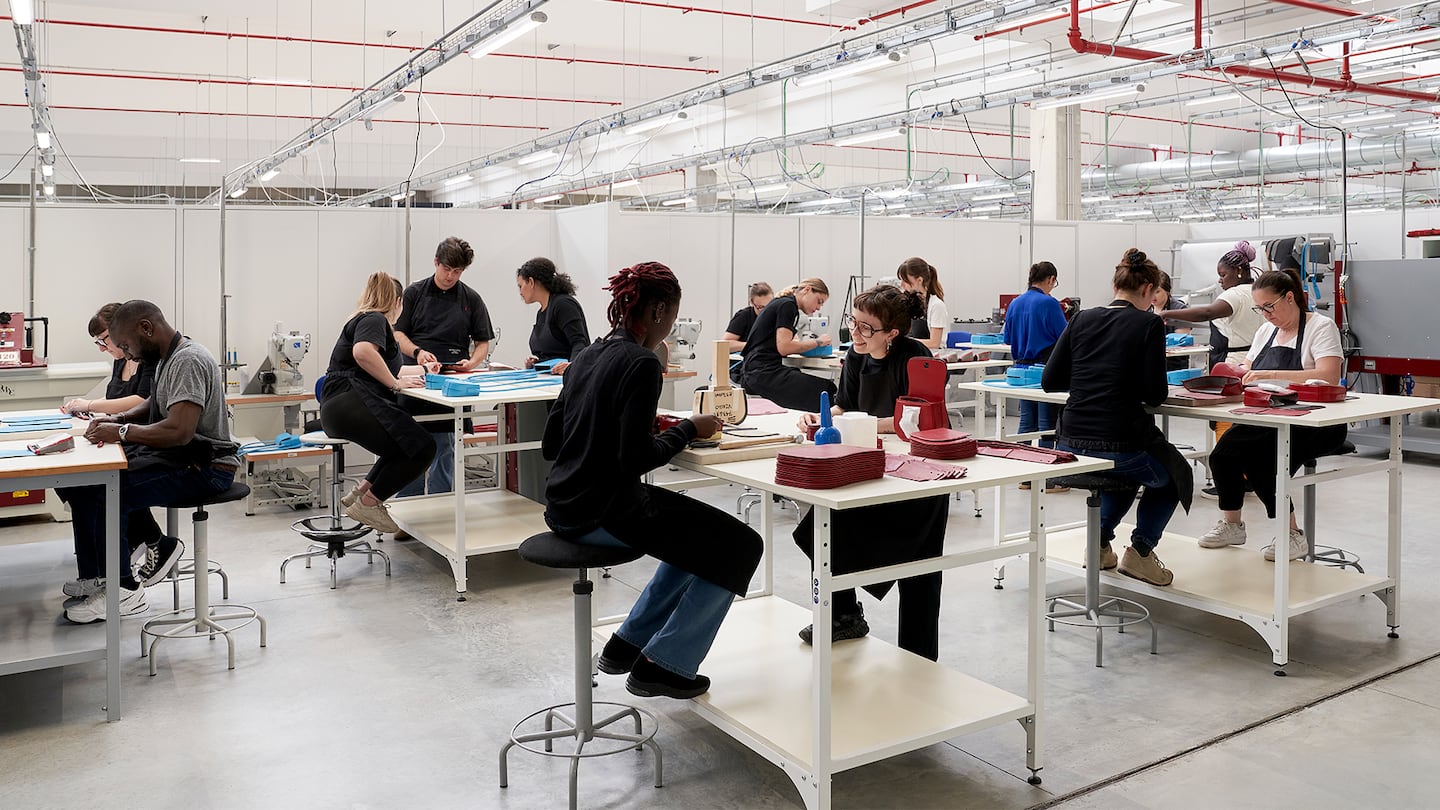
The Business of Fashion
Agenda-setting intelligence, analysis and advice for the global fashion community.

Agenda-setting intelligence, analysis and advice for the global fashion community.

Bottega Veneta’s most consequential launch this fall may not be a garment sent down the runway, but a new school for craftsmanship.
This week, the Kering-owned brand announced the opening of The Academia Labor et Ingenium, which is aimed at passing down the label’s heritage, techniques and craft know-how — known as “savoir faire” — through training courses. Based between Bottega’s Montebello Vicentino atelier and manufacturing site in Povolaro Dueville, Italy, the plan is to have five of Bottega Veneta’s master artisans train 50 students per year, with employment guaranteed at the end. The school will launch with a seven-week masterclass on bag design and development in collaboration with Universita Iuav di Venezia beginning Oct. 16. Bottega Veneta CEO Leo Rongone called it a “key strategic pillar to preserve Bottega Veneta’s unique savoir-faire.”
It’s the latest push from a luxury brand to establish a pipeline for young talent in craftsmanship, which includes areas such as leatherwork, draping, tailoring, pattern making, sewing and polishing.
The need is dire. At the end of 2022, 20,000 artisan-led jobs were left unfilled in France, according to estimates from Comité Colbert, a consortium of luxury brands; the organisation’s president and CEO Bénédicte Épinay said the number is likely higher. In the next three years, the Italian fashion industry will face a “critical situation in terms of resources” with 94,000 technical positions left open, according to luxury consortium Fondazione Altagamma. To boot, luxury’s rapid expansion over the past two decades has created record demand for these jobs.
ADVERTISEMENT
“Fashion companies are facing a major problem because nobody paid attention to what is happening in these areas. They’re facing massive retirement, meaning companies could lose their know-how,” said Hans de Foer, director of savoir-faire, at Paris’ Institut Français de la Mode.
To tackle what Samah Habib, managing director of fashion and luxury at Accenture called “one of the major challenges luxury groups have to tackle to sustain their growth,” companies are doubling down on initiatives for attracting and establishing pipelines of new talent.
Beyond Bottega, LVMH has its Métiers d’Excellence, a work-study programme aimed at training the next generation in skills needed in its 280 specialties. In 2021, Chanel unveiled a new campus for its craft and education programmes. Hermès, Prada and Brunello Cucinelli have their own schools, and Fendi, Ferragamo and Loro Piana partner with Italian schools through Altagamma and the Italian Ministry of Education’s “Adopt-a-School” initiative.
But building a skilled workforce comes with challenges. There’s the time and financial investment, plus brands have to drum up excitement for jobs often perceived as old-fashioned and tedious with limited mobility and a low profile.
“The new generations are not so much attracted to this type of profession,” said Alexandre Boquel, director of LVMH’s Métiers d’Excellence. “It’s essential, they create the product and experiences, without them it’s going to be impossible to manage and drive activity.”
Traditionally artisan skills have been passed down within family networks, or through word of mouth, said Adam Brand, vice president of New York-based fabric flower company M&S Schmalberg. As interest in craft careers dried up alongside the Garment District’s once-buzzing makers ecosystem, it became harder to find skilled talent.
Companies today have to cast a wider net. But because careers in fashion craftsmanship have long lacked visibility compared to more traditional design roles, many people still don’t know what they entail or that they exist at all.
“A lot of the major fashion schools put a heavy emphasis on design and that design is the end goal for students,’” said Gigi Burris O’Hara, a milliner and founder of Closely Crafted, a non-profit aimed at preserving American craft.
ADVERTISEMENT
To attract Gen-Z, fashion brands are hoping to spread the word — and debunk cliches that craft jobs are old-fashioned or a dead end.
“We cannot just take the heritage and push it to the young generation,” said Boquel. “They are the TikTok and Instagram generation, they want to be sure that they are connected to modernity.”
LVMH’s Métiers d’Art emphasises innovation and “engaging with the future” on its website, and Métiers d’Excellence hosts promotional tours across France, meeting with students as young as 13. It enlisted French basketball star Tony Parker as an ambassador; he appears in promotional videos and talks to students in-person about the programme during tours.
“When you want to be a sports player you need to train every day and be very passionate. [Parker] trained so much to be able to dunk … making a patina takes hours of practice to do. It’s the same thing,” said Boquel.
Some brands operate their own schools and facilities where they train workers based on their particular requirements, standards and routines. Doing so gives them first dibs on fresh talent, tailored to their needs.
Naples, Italy-based suit maker Kiton opened a school in 2000 when it noticed all the tailors in the area were over the age of 50. At no cost, Kiton offers classes on its traditional tailoring style, raw materials treatment and the English language. The brand has avoided hiring problems entirely, said president Maria Giovanna Paone, and placed 70 people in its factory from the school.
“The old generation retired and we had the substitution ready to be on production,” said Paone.
Even after finding the right people, it takes five to 10 years to master many of the in-demand craft careers facing mass retirement, said Épinay. At Texas bootmaker Lucchese, workers need up to a year to get running, even then, they’re still slow, leading to more operational snags, said Doug Hogue, Lucchese’s vice president, brand and product.
ADVERTISEMENT
Retaining talent is another challenge. In France, young, trained talent are increasingly opting to work freelance, said de Foer, because they would rather have flexibility than a full-time contract.
“It’s such an investment to train people … they could leave and you’re back at square one,” said Brand.
With that, companies are rethinking what these roles look like on a day-to-day basis. Wages are on the rise, but young people also want a career with more progression and variety, said Épinay. When Lucchese started bringing on new workers in 2020, Hogue noticed they wanted to learn every part of the process, from design to stitching and finishing.
“[The older generation] didn’t move around, they stayed in the same operations and that’s the way they like it. Younger workers like the diversity,” said Hogue. The company has adjusted workflow in the factory to fit new workers’ preferences.
LVMH, too, emphasises opportunities across the group, and Boquel said that the first role a budding artisan takes on can be “just a starting point within the company.”
Of course, it’s a balance — jumping around doesn’t square with becoming a master artisan.
“It’s a very long journey to learn every gesture. [Artisans] need to train every day. Clients expect perfection, the products need to be perfect,” said Boquel.
Brands are committed to finding and training talent: Since 2014, LVMH’s Métiers d’Excellence has placed 2,700 apprentices in training, including 500 last year. This year, it has 3,500 positions to fill, and is expanding its efforts in the US. Of those who finished programmes, 78 percent have been hired for jobs within LVMH or its partners.
But despite brands’ best efforts, it remains unclear if a generation that grew up online has that sort of patience. Épinay said she attended a class for young people hosted by Van Cleef and Arpels last year. When the master jeweller described how he trained for 10 years to make a necklace, the response was obvious.
“I saw it in their eyes. It was not possible for them to imagine such a career,” she said, laughing. “‘You had to train for 10 years to make your first necklace?’ It’s difficult for young people today to understand that.”
Disclosure: LVMH is part of a group of investors who, together, hold a minority interest in The Business of Fashion. All investors have signed shareholders’ documentation guaranteeing BoF’s complete editorial independence.
The French luxury conglomerate’s youth-focused recruitment plan underscores fashion’s need to build stronger more diverse talent pipelines.
From wage hikes to tuition assistance, fashion firms say they’re pulling out all the stops to revamp the store associate role — but their efforts aren’t taking hold.

Joan Kennedy is Editorial Associate at The Business of Fashion. She is based in New York and covers beauty and marketing.
Discover the most exciting career opportunities now available on BoF Careers — including jobs from Tapestry, Alexander McQueen and Toteme.
A US regulator has banned most uses of the clauses, which started as a way for fashion companies to prevent senior executives from walking off with trade secrets, but have become a standard retention tool.
Check out this week’s new partners and openings on BoF Careers, the global marketplace for fashion talent.
BoF Careers provides essential sector insights for fashion designers this month, to help you decode fashion’s creative and commercial landscape.